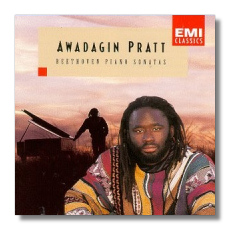
The Internet's Premier Classical Music Source
Related Links
- Beethoven Reviews
- Latest Reviews
- More Reviews
-
By Composer
-
Collections
DVD & Blu-ray
Books
Concert Reviews
Articles/Interviews
Software
Audio
Search Amazon
Recommended Links
Site News
 CD Review
CD Review
Ludwig van Beethoven

Piano Sonatas
- Sonata for Piano #7 in D Major, Op. 10/3 (1798)
- Sonata for Piano #9 in E Major, Op. 14/1 (1798)
- Sonata for Piano #30 in E Major, Op. 109 (1820)
- Sonata for Piano #31 in A Flat Major, Op. 110 (1822)
Awadagin Pratt, piano
EMI Classics 55290 DDD 73:46
This is Awadagin Pratt's second CD, and it confirms the excellent impression made by the first: here is a artist who is much more mature than his twenty-eight years suggest. After he won the Naumburg International Piano Competition in 1992, he often was featured in the popular media, probably as much for his non-traditional appearance (dreadlocks, urban-chic clothing) as for his multiple musical talents. (He also received diplomas in violin and conducting from the Peabody Conservatory of Music.) EMI Classics can't be accused of avoiding similar gimmickry. They entitled his first CD "A Long Way From Normal" (Pratt spent part of his childhood in Normal, Illinois), and the photography for the current release has Pratt modeling not a tuxedo, but a) a long leather coat, b) an African print shirt, and c) an African knit sweater. He holds a fat stogie in one of the three pictures. (Tsk-tsk.) OK, we get the point!
The important thing is the music and Pratt's approach to it, and EMI has been right on the money here. It's a good sign that Pratt has not been rushed into the recording studios to do the canonical concerto and sonata recordings - Lord knows EMI could sell them. One gets the feeling that Pratt doesn't do anything until he's ready to, and that he isn't interested merely in filling gaps (real or perceived) in the record catalogs. These four sonatas have been in Pratt's recital repertoire, and it was the Op. 110 sonata that fueled his Naumburg victory. These are seasoned performances.
Perhaps "seasoned" is the right word to use, because Pratt's Beethoven is spicy and wide-awake. At the same time, I am reminded of that old back-handed compliment about Van Cliburn's playing - "Van plays pretty" - but without its negative connotations. Pratt definitely "plays pretty," but his beautiful tone complements his obviously strong sense of the music's logic and meaning. His approach to the two early sonatas is straightforward, except for occasional fussing with tempos. However, this quirk bothered me less the more that I heard these performances. The two later sonatas are even better; this visionary music is better suited to Pratt's flexibility and creativity. The pianist turns the Fugue that closes Op. 110 into a heroic experience, and the Op. 109 Theme and Variations into a genunitely seraphic one (although I find some of Pratt's tempos in this movement to be a little fast.) Don't be scared away by what you might have heard about Pratt: he thinks for himself, but he's not a distorter, and, if anything, this second CD, is less controversial than the first, which had its mannered moments. I look forward to Pratt's future work. I think that he has a great Beethoven cycle in him. Now the important thing to do is to nurture him, not to push him.
Copyright © 1998, Raymond Tuttle


















